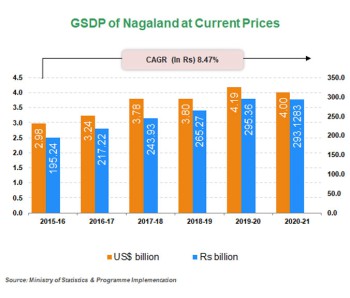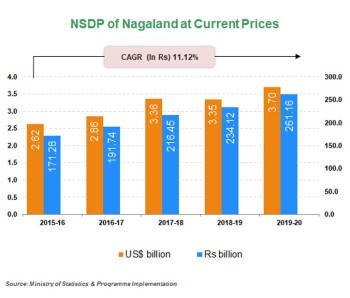INTRODUCTION
Nagaland is one of the seven northeast states and is located on India’s farthest east side. The state is flanked by Myanmar in the east, Arunachal Pradesh in the north, Assam in the west, and Manipur in the south.
The state has considerable resources of natural minerals, petroleum, and hydropower. It has unexploited reserves of around 600 million metric tonnes (MT) of crude oil and more than 20 MT of hydrocarbon. Moreover, the state has 315 MT of coal reserves and 1,038 MT of limestone reserves.
The agro-climatic conditions in Nagaland provide commercial opportunities for floriculture and horticulture. The state has 650 indigenous species of medicinal and aromatic plants. In 2019-20, the total production of horticulture crops in the state was estimated at 847.83 thousand metric tonnes and the area under production was 88.35 thousand hectares. In 2019-20, the total production of vegetables and fruits were estimated at 453.65 thousand metric tonnes and 315.05 thousand metric tonnes, respectively.
Bamboo is found extensively in Nagaland, with bamboo growing stock covering nearly 5%of the total stock in the country. As of 2018, Nagaland had 46 species of bamboo. Production of raw silk in the Nagaland stood at about ~620 MT in 2018-19 and 600 MT in 2019-20.
As of April 2021, Nagaland had a total installed power-generation capacity of 179.03 MW, of which 147.36 MW was under the central sector, state utilities (30.67 MW) and private sector (1.00 MW). Of the total installed power-generation capacity, 81.03 MW was contributed by thermal, 66.33 MW by hydro and 31.67 MW by renewable energy.
Total exports from the state stood at US$ 5.71 million in 2019-20 and US$ 6.06 million in 2020-21. Major items exported from Nagaland are ceramic and allied products, electric machinery & equipment, electronics component, human hair, product thereto, electronics instrument and cotton fabrics & made-ups. In 2020-21, total exports of electric machinery from Nagaland stood at US$ 1.48 million (~24.4%).
The state provides institutional support through various central and state government agencies viz., North East Council, Ministry of Development of North Eastern Region and Nagaland Industrial Development Council.
The state offers excellent policy and fiscal incentives for agro-based and forest-based industries, horticulture, food processing, mining, tourism, and the handlooms and handicrafts sectors. Industrial centres and special economic zones (SEZs) are being developed to enhance the marketability of products. As of August 2020, the state has two formally approved SEZs.
According to the Department for Promotion of Industry and Internal Trade (DPIIT), FDI inflow to other* states totalled US$ 345.49 million between October 2019 and March 2021.



KEY SECTORS
- Nagaland promotes bamboo processing as an enterprise, covering various applications such as food-based, medicinal usage, handicraft, art, tiles and flooring. Nagaland Bamboo Development Agency (NBDA) is the nodal office that coordinates with other offices for all bamboo-related research, development and business applications.
- Nagaland has a rich wealth of flora and fauna. Favourable climatic and geographical conditions in the state offer tremendous scope for floriculture.
- Nagaland has a suitable climate for agricultural and horticultural produce. It supports multiple crops viz., rice, maize, millet, gram, mustard, bean, sugarcane, rubber, tea, banana, pineapple, orange, jackfruit, pear, plum, passion fruit, litchi, mango, lemon, sweet lime, potato, sweet potato, tapioca, tomato, pea, chilly, ginger, garlic, cardamom, etc.
Note: MW – Megawatt, * Combined figures for Nagaland, Meghalaya, Manipur, Mizoram, Andaman and Nicobar Islands and Lakshadweep